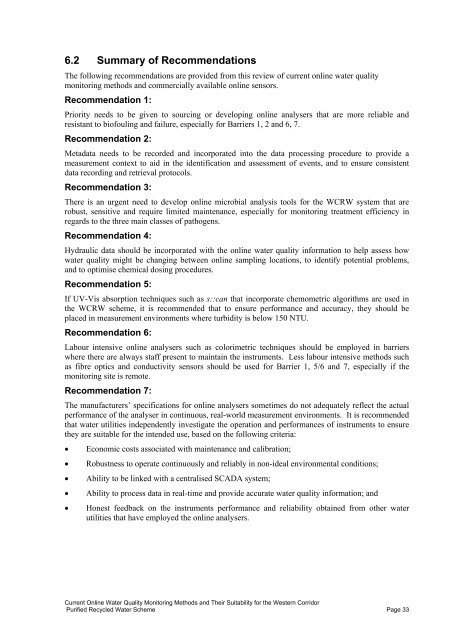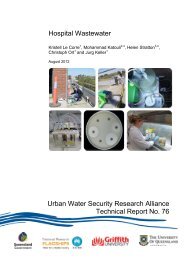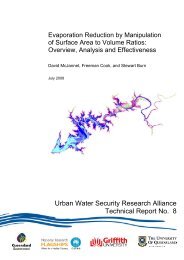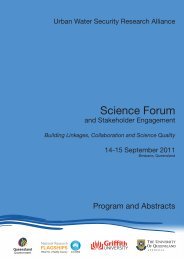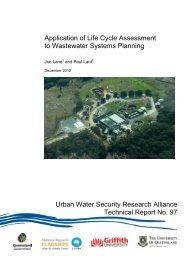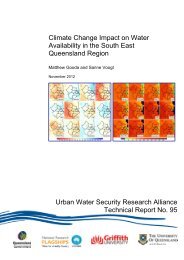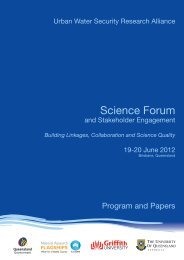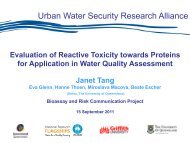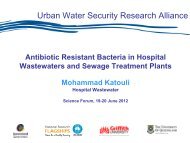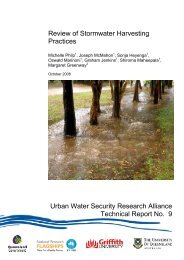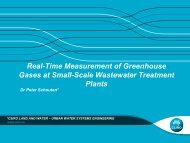Increased likelihood of false positive <strong>and</strong> false negative events;Decreased likelihood of detecting short <strong>and</strong> long-term trends from baseline <strong>monitoring</strong>conditions; <strong>and</strong> Large volumes of redundant data being produced but not being useable to optimise operational<strong>monitoring</strong> procedures.To improve the performance of existing <strong>online</strong> systems, commercial <strong>and</strong> research endeavours havefocused on improving sensor selectivity; reducing reagent consumption; overcoming matrixinterferences; <strong>and</strong> simplifying calibration <strong>and</strong> sample pre-treatment requirements. However asevidenced by the review, there is not one single approach that has been implemented that can resolvemost of the problems associated with improving <strong>online</strong> <strong>monitoring</strong> performance. This is especially thecase for those <strong>methods</strong> that are based on direct adaptations of traditional laboratory-based <strong>methods</strong>.To overcome the logistics <strong>and</strong> economic costs associated with maintaining reliable <strong>online</strong>measurements <strong>and</strong> improve <strong>their</strong> widespread application, it is clearly evident that <strong>online</strong> technologyshould be redesigned to operate continuously in changeable measurement environments. Therefore,there is an urgent need to develop cost-effective <strong>online</strong> <strong>water</strong> <strong>quality</strong> <strong>monitoring</strong> technology that canmaintain its calibrated status for prolonged periods of time <strong>and</strong> operate reliably irrespective ofenvironmental or sample matrix conditions. It is also highly desirable that the instruments should uselimited or no reagents, <strong>and</strong> be more resistant to fouling, signal drift <strong>and</strong> matrix interferences.From the review of commercially available <strong>online</strong> analysers it was evident that obtaining reliable lowmaintenance continuous <strong>online</strong> analysers for Barriers 1 <strong>and</strong> 2 is problematic. Monitoring in theselocations is currently a real challenge for commercial systems due to the complex nature of themeasurement environment. In addition, many of the systems available are too expensive to allow <strong>their</strong>widespread use.In regards to <strong>monitoring</strong> of heavy metals, <strong>online</strong> sensors must have adequate sensitivity for Barrier 2<strong>and</strong> high sensitivity for Barriers 5-7. It was evident that a cost-effective technique is required, asdirect adaptations of conventional laboratory-based <strong>methods</strong> such as AAS <strong>and</strong> ICP-MS are unsuitable<strong>online</strong> <strong>monitoring</strong> tools due to <strong>their</strong> high expense, along with separation, extraction <strong>and</strong> maintenancecosts. Electronic tongues or voltametric <strong>methods</strong> may offer an alternative, <strong>and</strong> several such devicesare currently being commercially developed.With regards to <strong>online</strong> analysers for rapid microbial detection, there are at present only surrogateindicators commercially available, such as turbidity or free chlorine analysers. Although biosensorsshow promise, there are no commercially available sensors with equivalent performance to equivalentchemical sensors. It is possible that electronic tongues or software sensors may offer promise in thisarea. Therefore it is recommended that, as a high priority, robust, sensitive <strong>and</strong> low maintenance<strong>online</strong> microbial analysis tools should be developed for the WCRW system, especially to detect thethree main classes of pathogens.For Pesticides, EDCs, Pharmaceuticals, THMs, NDMA <strong>and</strong> VOCs, there are no commercially <strong>and</strong>economically viable <strong>online</strong> <strong>monitoring</strong> systems available for the WCRW scheme. E-tongues, E-noses<strong>and</strong> software sensors may offer some potential in the future if further developed. They have thepotential to reduce the number of analysers required for the scheme whilst maximising the number of<strong>water</strong> <strong>quality</strong> parameters that can be determined. They would also reduce reagent costs <strong>and</strong>maintenance associated with the <strong>monitoring</strong>. However, the following should be taken into accountwhen developing systems of this nature:Need rugged reference electrodes to reduce risk of contamination through liquid junctions; Must be resistant to biofouling especially in Barriers 1, 2 <strong>and</strong> 6;Improved data analysis techniques are required to make software sensors more suitable for longtermdeployment applications by reducing signal drift; <strong>and</strong>Minimise consumption of reagents, so that they can be suitable for remote <strong>monitoring</strong>applications.<strong>Current</strong> Online Water Quality Monitoring Methods <strong>and</strong> Their Suitability for the Western CorridorPurified Recycled Water Scheme Page 32
6.2 Summary of RecommendationsThe following recommendations are provided from this review of current <strong>online</strong> <strong>water</strong> <strong>quality</strong><strong>monitoring</strong> <strong>methods</strong> <strong>and</strong> commercially available <strong>online</strong> sensors.Recommendation 1:Priority needs to be given to sourcing or developing <strong>online</strong> analysers that are more reliable <strong>and</strong>resistant to biofouling <strong>and</strong> failure, especially for Barriers 1, 2 <strong>and</strong> 6, 7.Recommendation 2:Metadata needs to be recorded <strong>and</strong> incorporated into the data processing procedure to provide ameasurement context to aid in the identification <strong>and</strong> assessment of events, <strong>and</strong> to ensure consistentdata recording <strong>and</strong> retrieval protocols.Recommendation 3:There is an urgent need to develop <strong>online</strong> microbial analysis tools for the WCRW system that arerobust, sensitive <strong>and</strong> require limited maintenance, especially for <strong>monitoring</strong> treatment efficiency inregards to the three main classes of pathogens.Recommendation 4:Hydraulic data should be incorporated with the <strong>online</strong> <strong>water</strong> <strong>quality</strong> information to help assess how<strong>water</strong> <strong>quality</strong> might be changing between <strong>online</strong> sampling locations, to identify potential problems,<strong>and</strong> to optimise chemical dosing procedures.Recommendation 5:If UV-Vis absorption techniques such as s::can that incorporate chemometric algorithms are used inthe WCRW scheme, it is recommended that to ensure performance <strong>and</strong> accuracy, they should beplaced in measurement environments where turbidity is below 150 NTU.Recommendation 6:Labour intensive <strong>online</strong> analysers such as colorimetric techniques should be employed in barrierswhere there are always staff present to maintain the instruments. Less labour intensive <strong>methods</strong> suchas fibre optics <strong>and</strong> conductivity sensors should be used for Barrier 1, 5/6 <strong>and</strong> 7, especially if the<strong>monitoring</strong> site is remote.Recommendation 7:The manufacturers’ specifications for <strong>online</strong> analysers sometimes do not adequately reflect the actualperformance of the analyser in continuous, real-world measurement environments. It is recommendedthat <strong>water</strong> utilities independently investigate the operation <strong>and</strong> performances of instruments to ensurethey are suitable for the intended use, based on the following criteria: Economic costs associated with maintenance <strong>and</strong> calibration;Robustness to operate continuously <strong>and</strong> reliably in non-ideal environmental conditions;Ability to be linked with a centralised SCADA system;Ability to process data in real-time <strong>and</strong> provide accurate <strong>water</strong> <strong>quality</strong> information; <strong>and</strong>Honest feedback on the instruments performance <strong>and</strong> reliability obtained from other <strong>water</strong>utilities that have employed the <strong>online</strong> analysers.<strong>Current</strong> Online Water Quality Monitoring Methods <strong>and</strong> Their Suitability for the Western CorridorPurified Recycled Water Scheme Page 33


